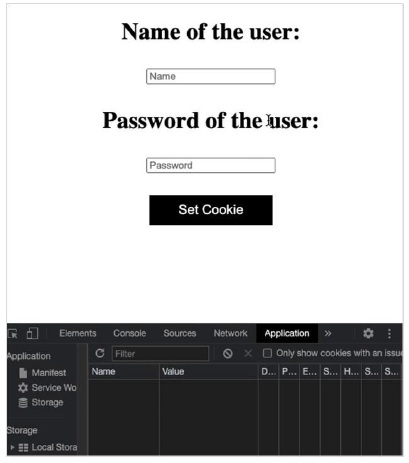
 Data Structure
Data Structure Networking
Networking RDBMS
RDBMS Operating System
Operating System Java
Java MS Excel
MS Excel iOS
iOS HTML
HTML CSS
CSS Android
Android Python
Python C Programming
C Programming C++
C++ C#
C# MongoDB
MongoDB MySQL
MySQL Javascript
Javascript PHP
PHP
- Selected Reading
- UPSC IAS Exams Notes
- Developer's Best Practices
- Questions and Answers
- Effective Resume Writing
- HR Interview Questions
- Computer Glossary
- Who is Who
How to set cookies in ReactJS?
In this chapter, we are going to see how to set, remove and retrieve cookies in a React application.
Cookies are the data stored in the form of key-value pairs that are used to store information about the user on their computer by the websites that the users browse and use it to verify them.
To set or remove the cookies, we are going to use a third-party dependency of react-cookie.
Installing the module
npm install react-cookie
Or,
yarn add react-cookie
Npm is the node package manager which manages our React package but yarn is the more secure, faster and lightweight package manager.
Setting up cookies
In this example, we will build a React application that takes the username and password from the user and stores it as a cookie in the user's computer.
Firstly, wrap the index.js or the root app component of your application with the CookiesProvider component from the react-cookie package.
After that use the useCookies hook provided by it which has a syntax of ?
Syntax
const [cookies, setCookie, removeCookie] = useCookies(['cookie-name']);
Parameter
Cookies: JavaScript object with all of the user's cookies.
setCookie: Function to set the cookies.
removeCookie: Function to remove the cookies.
Example
index.jsx
import React from "react"; import ReactDOM from "react-dom"; import { CookiesProvider } from "react-cookie"; import App from "./App"; ReactDOM.render( <CookiesProvider> <App /> </CookiesProvider>, document.getElementById('root') );
App.jsx
import React, { useState } from 'react'; import { useCookies } from 'react-cookie'; const App = () => { const [name, setName] = useState(''); const [pwd, setPwd] = useState(''); const [cookies, setCookie] = useCookies(['user']); const handle = () => { setCookie('Name', name, { path: '/' }); setCookie('Password', pwd, { path: '/' }); }; return ( <div className="App"> <h1>Name of the user:</h1> <input placeholder="name" value={name} onChange={(e) => setName(e.target.value)} /> <h1>Password of the user:</h1> <input type="password" placeholder="name" value={pwd} onChange={(e) => setPwd(e.target.value)} /> <div> <button onClick={handle}>Set Cookie</button> </div> </div> ); }; export default App;
In the above example, when the Set-Cookie button is clicked then the handle function is executed which will set the cookies for the user. The path:'/' signifies that the cookie is available for all the pages of the website.
Output
This will produce the following result.

Retrieving cookies
After the cookies have been set, we can access them by writing cookies.{cookies key name}
Example
App.jsx
import React, { useState } from 'react'; import { useCookies } from 'react-cookie'; const App = () => { const [name, setName] = useState(''); const [pwd, setPwd] = useState(''); const [cookies, setCookie] = useCookies(['user']); const handle = () => { setCookie('Name', name, { path: '/' }); setCookie('Password', pwd, { path: '/' }); }; return ( <div className="App"> <h1>Name of the user:</h1> <input placeholder="Name" value={name} onChange={(e) => setName(e.target.value)} /> <h1>Password of the user:</h1> <input type="password" placeholder="Password" value={pwd} onChange={(e) => setPwd(e.target.value)} /> <div> <button onClick={handle}>Set Cookie</button>{' '} </div> <br /> {cookies.Name && ( <div> Name: <p>{cookies.Name}</p> </div> )} {cookies.Password && ( <div> Password: <p>{cookies.Password}</p> </div> )} </div> ); }; export default App;
In the above example, when the Set Cookie button and the cookies are set, the value of these cookies will be displayed accordingly.
Output
This will produce the following result.


